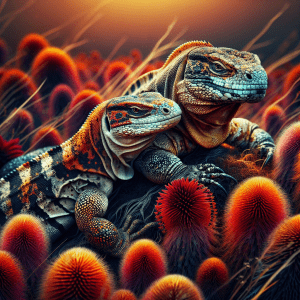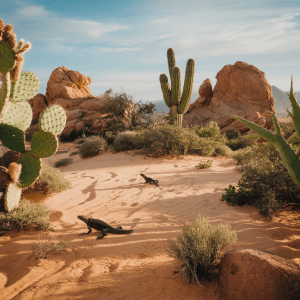Introduction to Common North American Lizards
Welcome, fellow lizard enthusiasts! Today, we’re diving into the captivating world of Common North American Lizards. These fascinating reptiles hold a special place in my heart, reminding me of a thrilling encounter I had while hiking in the Arizona desert. Picture this: the sun beating down, casting a warm glow over the rocky terrain, when suddenly, a sleek lizard darted past me, blending seamlessly into its surroundings. It was a magical moment that fueled my passion for these incredible creatures.
Let’s talk about the incredible diversity of lizard species you can find right here in North America. From the iconic Western Fence Lizard to the colorful Collared Lizard, each species has its own unique characteristics and behaviors that make them a delight to observe in the wild. Did you know that some lizards can change color to match their environment, providing them with camouflage and protection from predators? It’s a remarkable adaptation that showcases the ingenuity of these reptiles.
As we delve deeper into the world of Common North American Lizards, we’ll uncover the challenges they face in today’s rapidly changing environment. Climate change, habitat loss, and human encroachment are just a few of the threats that these resilient creatures must contend with. Understanding these challenges is crucial to implementing effective conservation efforts that will ensure the survival of these iconic species for generations to come.
So, what can we do to protect and preserve the habitats of these remarkable lizards? One practical tip is to support local conservation organizations dedicated to safeguarding the natural habitats of North American lizards. By raising awareness, advocating for conservation policies, and participating in citizen science projects, we can all play a part in protecting these beloved reptiles.
As we continue our journey through the world of Common North American Lizards, I invite you to join me in exploring the wonders of these creatures and the important role they play in our ecosystem. Together, let’s celebrate the beauty and diversity of these incredible reptiles and work towards a future where they thrive in harmony with nature.
Top Species of Common North American Lizards
Have you ever marveled at the remarkable diversity of common North American lizards? Let’s dive into the fascinating world of these reptiles and explore the top species that grace the landscapes of North America.
Imagine encountering a Western Fence Lizard basking in the sun, its intricate scales shimmering in the light. These lizards are known for their swift movements and impressive climbing abilities. Or perhaps you’ve come across a charismatic Horned Lizard, with its unique spiky appearance and specialized diet of ants. Each species has its own distinct characteristics that make them a vital part of the ecosystem.
As we delve deeper into the world of common North American lizards, let’s not forget the Anole lizards, known for their color-changing abilities and territorial behaviors. These small but mighty creatures are a joy to observe in their natural habitats, showcasing nature’s wonders in their own right.
Did you know that some common North American lizards have the ability to detach their tails as a defense mechanism against predators? This regenerative ability allows them to escape from danger and survive in the wild. Nature’s adaptations never cease to amaze!
From the deserts of the Southwest to the forests of the Northeast, these lizards have adapted to diverse habitats and climates, showcasing their resilience and evolutionary prowess. Exploring the habitats and distribution of these reptiles offers a glimpse into the intricate web of life that exists in our own backyards.
So, the next time you venture into nature, keep an eye out for these fascinating creatures. Whether you’re a seasoned herpetologist or a nature enthusiast, common North American lizards never fail to captivate with their beauty and diversity. Stay tuned for more insights into the enchanting world of these remarkable reptiles.
Characteristics and Physical Features
Have you ever taken a closer look at the remarkable characteristics and physical features of Common North American Lizards? These fascinating creatures are truly captivating in their unique traits. Let’s dive into the world of North American lizards and uncover what makes them so intriguing.
When you observe these lizards up close, you’ll notice their diverse range of colors and patterns that serve as camouflage in their natural habitats. From the vibrant hues of the Eastern Collared Lizard to the intricate markings of the Five-lined Skink, each species showcases its own distinctive appearance that has evolved over time for survival.
One interesting fact about the physical features of North American lizards is their ability to regenerate their tails. Yes, you heard that right! In response to a predator attack or injury, these resilient creatures can detach their tails as a defense mechanism and later grow a new one. It’s like having a built-in superhero power of regeneration!
The texture of their skin is another fascinating aspect. Many North American lizards have rough, scaly skin that helps them retain moisture and provides protection against predators. Some species even have spiny projections or frills on their bodies, adding an extra layer of defense and a touch of uniqueness to their overall appearance.
As you delve deeper into the world of Common North American Lizards, take a moment to appreciate the intricate details of their physical features and how they play a crucial role in their survival. These remarkable adaptations have enabled these creatures to thrive in diverse environments and continue to fascinate researchers and nature enthusiasts alike.
Habitats and Distribution
When delving into the diverse world of Common North American Lizards, one cannot overlook the fascinating habitats and distribution patterns that these reptiles inhabit. Imagine stumbling upon a majestic Western Fence Lizard basking in the sun on a rocky outcrop, perfectly blending into its surroundings. These lizards have a remarkable ability to adapt to various environments, from arid deserts to lush forests, showcasing their incredible resilience and survival instincts.
One interesting fact about the habitats of Common North American Lizards is their preference for specific microclimates within their range. For instance, the iconic Horned Lizard thrives in arid regions with sandy soil, where its cryptic coloration helps it evade predators. Similarly, the colorful Collared Lizard is often found in rocky areas, using its speed and agility to navigate the terrain.
The distribution of Common North American Lizards is not random but influenced by factors such as temperature, humidity, prey availability, and competition with other species. Some species, like the Green Anole, are adept climbers and can be found in trees and shrubs, while others, such as the Eastern Fence Lizard, prefer open woodland areas with plenty of sunlight.
Understanding the habitats and distribution of these lizards provides valuable insights into their ecological roles and conservation needs. As habitats face increasing threats from human activities and climate change, it is crucial to protect these areas to ensure the survival of these unique reptiles.
By appreciating the intricate relationship between Common North American Lizards and their habitats, we gain a deeper understanding of the natural world and the importance of preserving biodiversity. Next time you spot a lizard sunning itself on a rock or darting through the undergrowth, take a moment to marvel at the wonders of nature and the remarkable adaptations of these fascinating creatures.
Behavior and Adaptations
Now, let’s dive into the fascinating world of Common North American Lizards and explore their behaviors and adaptations.
Imagine you’re hiking through a dense forest, and suddenly you spot a vibrant green Anole lizard darting up a tree trunk. These agile creatures are known for their quick movements and ability to change color, blending seamlessly with their surroundings. An interesting fact about Anole lizards is that they can communicate through complex body language, such as head-bobbing and dewlap displays, to establish dominance or attract mates.
When it comes to behaviors and adaptations, Common North American Lizards showcase a diverse range of strategies for survival. From the spiny scales of the Horned Lizard, which help deter predators, to the regenerative tail of the Common Five-lined Skink, these reptiles have evolved remarkable defenses. Have you ever wondered how these lizards navigate their environments with such precision? Their keen sense of sight, smell, and touch allows them to hunt for prey efficiently and evade danger.
Consider the practical tip of observing lizard behavior in their natural habitats to gain a deeper understanding of their adaptations. By paying attention to their movements, communication signals, and feeding habits, you can unravel the mysteries of these fascinating creatures. Next time you encounter a Common North American Lizard, take a moment to appreciate the intricate balance of nature at play.
As we unravel the complexities of Common North American Lizards, we begin to see the interconnectedness of species within their ecosystems. These reptiles play a crucial role in controlling insect populations and maintaining biodiversity. The next time you spot a lizard basking in the sun, ponder the broader implications of their presence in the ecosystem and the delicate balance of nature they help uphold.
Importance in the Ecosystem
As we delve into the importance of Common North American Lizards in the ecosystem, it’s fascinating to consider the crucial role they play in maintaining the balance of nature. These remarkable creatures are not just intriguing to observe, but they also contribute significantly to the environment around us.
Lizards are known for their diverse diets, which often include insects such as beetles, ants, and grasshoppers. By preying on these insects, lizards help regulate their populations, preventing potential outbreaks that could harm crops and vegetation. This natural form of pest control is essential for preserving the health of ecosystems and agricultural lands alike.
Moreover, the presence of lizards in an area can indicate the overall health of the ecosystem. As sensitive creatures, they are quick to respond to changes in their surroundings, making them valuable indicators of environmental quality. A decline in lizard populations can signal underlying issues such as habitat destruction, pollution, or climate change, prompting us to take action to address these challenges.
Consider this: Did you know that some species of lizards are capable of regenerating lost limbs? This remarkable ability not only aids in their survival but also holds potential implications for regenerative medicine research. Studying the mechanisms behind lizard limb regeneration could offer valuable insights for human health and the field of tissue engineering.
By understanding and appreciating the importance of Common North American Lizards in the ecosystem, we gain a deeper appreciation for the interconnected web of life that sustains us all. Next time you spot a lizard basking in the sun or darting across a trail, take a moment to reflect on the vital role these fascinating creatures play in maintaining the delicate balance of nature.
Threats and Conservation Efforts
Conservation efforts play a crucial role in ensuring the survival of common North American lizards. It’s not just about protecting these fascinating creatures; it’s about safeguarding the delicate balance of our ecosystems. Imagine a world where these lizards disappear, leaving a void in the natural world that cannot be filled.
One interesting fact about conservation efforts for North American lizards is the concept of habitat restoration. By restoring and preserving their natural habitats, we provide these lizards with a fighting chance for survival. I once witnessed a team of dedicated conservationists working tirelessly to restore a degraded lizard habitat. It was awe-inspiring to see how their efforts directly impacted the lizard population, leading to a resurgence in numbers over time.
Preserving the habitats of common North American lizards is not just about protecting a single species; it’s about preserving the interconnected web of life that sustains us all. Every plant, insect, and animal plays a vital role in the ecosystem, and when one piece goes missing, the entire puzzle is affected.
So, as you delve into the world of common North American lizards, think about the bigger picture. Consider the impact of human activities on these creatures and reflect on what we can do to ensure their continued existence. Conservation efforts may seem daunting, but each small step we take can make a significant difference in the long run. Let’s work together to protect these enchanting creatures and the ecosystems they call home.
Interesting Facts About North American Lizards
When it comes to interesting facts about Common North American Lizards, one fascinating aspect to consider is their incredible diversity and unique adaptations. These cold-blooded creatures have evolved over millions of years to thrive in various environments, showcasing a wide range of behaviors and physical characteristics.
Imagine stumbling upon a Western Fence Lizard basking in the sun on a rocky outcrop, its vibrant blue belly shimmering in the light. This species is known for its distinct coloration and the ability to change its hue depending on environmental conditions. The sight of this lizard blending seamlessly into its surroundings is a testament to the wonders of nature’s camouflage.
As you delve deeper into the world of Common North American Lizards, you’ll discover the Horned Lizard, also known as the “horny toad.” Despite its name, this lizard is not a toad at all but a unique creature with a spiky appearance and a remarkable defense mechanism. When threatened, the Horned Lizard can shoot blood from its eyes as a deterrent to predators—an extraordinary adaptation that sets it apart from other lizard species.
Consider the Anole Lizard, a master of acrobatics and color-changing abilities. These agile creatures can perform impressive feats of agility, leaping from branch to branch with ease. Their ability to change color based on mood and temperature adds an element of intrigue to their already captivating presence.
Exploring the world of Common North American Lizards is like embarking on a thrilling adventure filled with surprises at every turn. From the elusive Gila Monster to the speedy Collared Lizard, each species offers a glimpse into the rich tapestry of biodiversity that exists in our own backyard.
So, the next time you spot a lizard darting across your path or sunning itself on a rock, take a moment to appreciate the marvels of these fascinating creatures and the extraordinary adaptations that make them truly remarkable.
How to Identify Common North American Lizards
Have you ever tried to identify common North American lizards in the wild? It can be quite the adventure, especially when you know what to look for. One practical tip for spotting these elusive creatures is to pay attention to their unique physical characteristics.
For example, did you know that some lizards have specialized adaptations that help them thrive in their environments? From camouflage patterns that blend seamlessly with their surroundings to distinct markings that serve as warning signals to predators, each species has its own fascinating features.
Imagine stumbling upon a Western Fence Lizard basking in the sun, its vibrant blue belly catching your eye. This personal anecdote reminds me of a memorable encounter with this species during a hike in the desert. Observing its behavior up close allowed me to appreciate the intricate details that make these lizards so remarkable.
Identifying common North American lizards is not just about spotting them but also understanding their significance in the ecosystem. These reptiles play a crucial role in controlling insect populations and serving as prey for larger predators. By learning to identify them, we can better appreciate the interconnectedness of species in our natural world.
As you embark on your own lizard-spotting adventures, remember to respect their habitats and observe from a distance. Take a moment to marvel at the intricate patterns on their scales and the agility with which they navigate their surroundings. Each encounter with these fascinating creatures offers a glimpse into the diverse and dynamic world of North American lizards.
Conclusion and Key Takeaways
Have you ever marveled at the diverse world of Common North American Lizards? These remarkable creatures are truly fascinating, each with its own unique traits and behaviors. As a passionate expert in the field, I am thrilled to share my insights with you.
Let’s dive into the enchanting world of Common North American Lizards. These reptiles come in a variety of shapes, sizes, and colors, making them a captivating subject of study for nature enthusiasts. One interesting fact about these lizards is their remarkable ability to adapt to different environments, from deserts to forests and even urban areas.
One of the top species you may encounter is the Western Fence Lizard, known for its striking blue belly and agile movements. Observing these lizards in their natural habitat can be a rewarding experience, offering a glimpse into their daily routines and interactions with the environment.
As we explore the characteristics and physical features of Common North American Lizards, you’ll be amazed by their intricate patterns and camouflage techniques. Their habitats and distribution play a crucial role in their survival, highlighting the delicate balance of nature.
Now, imagine yourself in the midst of a lush forest, spotting a Common North American Lizard basking in the sun. How would you identify this species? Understanding the key features and behaviors can help you appreciate the beauty and diversity of these intriguing reptiles.
As we delve deeper into the world of Common North American Lizards, it’s essential to consider their significance in the ecosystem. These creatures play a vital role in maintaining ecological balance and are indicators of environmental health.
So, next time you encounter a Common North American Lizard, take a moment to observe its grace and resilience. By appreciating these remarkable creatures, we can develop a deeper connection to the natural world around us.




